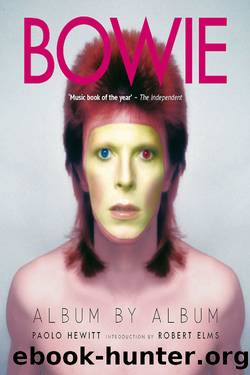Bowie: Album by Album by Paolo Hewitt

Author:Paolo Hewitt [Hewitt, Paolo]
Language: eng
Format: epub
Tags: Art, Autobiography, Biography, Music, Performing Arts, Popular Culture
ISBN: 9781608879212
Google: kw3bjwEACAAJ
Amazon: 1608879216
Publisher: Insight Editions
Published: 2016-10-03T23:00:00+00:00
TIN MACHINE II (1991)
‘TIN MACHINE WAS THE BEST THING I COULD HAVE DONE TO SOLVE MY MID-FORTIES CRISIS.’1
DAVID BOWIE, 1994
1989
June: Release of Tin Machine’s ‘Under The God’/ ‘Sacrifice Yourself’ (UK 51, US DNC)
14 June: 1989 Tin Machine tour opens at the World, New York
3 July: 1989 Tin Machine tour closes at the Forum, Livingston, Scotland (an additional gig added, 4 November, Moby Dick’s, Sydney)
September: Release of Tin Machine’s ‘Tin Machine’/ ‘Maggie’s Farm (live)’ (UK 48, US DNC)
October: Release of Tin Machine’s ‘Prisoner Of Love’/ ‘Baby Can Dance (live)’ (DNC)
1990
March: Release of ‘Fame ’90’/ ‘Fame ’90 (Queen Latifah’s rap version)’ (UK 28, US DNC)
4 March: Sound+Vision tour opens at the Colisée, Quebec
2 April: Wins Ivor Novello Award for Outstanding Contribution to British Music
May: Release of Adrian Belew’s ‘Pretty Pink Rose’/ ‘Neptune Pool’/ ‘Shoe Salesman’/ ‘Oh Daddy’ (featuring David Bowie on track one) (DNC)
29 September: Sound+Vision tour closes at the River Plate Stadium, Buenos Aires
1991
7 July: Appears as Sir Roland Moorcock in two episodes of HBO’s Dream On
August: UK release of Tin Machine’s ‘You Belong In Rock ’n’ Roll’/ ‘Amlapura (Indonesian version)’ (33)
2 September: Release of Tin Machine II (UK 23, US DNC)
If many felt Bowie’s musical imagination had temporarily been put on hold – though it would soon return in splendour – he retained the capacity to surprise.
In March 1990 he embarked on the Sound+Vision tour. This, he explained, would be the last time he sang his old hits on stage; one last outing for the songs that had made him famous, after which his past would remain just that – the past. He hoped that by doing so, he’d open up his future.
‘Knowing I won’t ever have those songs to rely on again spurs me to keep doing new things, which is good for an artist.’2 DB, 1990
The tour was also a way of promoting a career-spanning box set of the same name, full of rarities and curios. And this, in turn, was designed to drum up interest in an ongoing programme of album reissues with EMI and Rykodisc.
Ahead of the tour, in an to effort to break the wall between performer and audience, Bowie set up a phone line for fans to request their favourite songs to be played live. The British music paper NME quickly realised the potential for making mischief and the line was overrun by readers requesting ‘The Laughing Gnome’.
In the US, ‘Fame’, ‘Let’s Dance’ and ‘Changes’ were requested most, while in Europe it was “Heroes” and ‘Blue Jean’.
This time, Bowie lost the accoutrements of the Glass Spider extravaganza. Dressed like the Thin White Duke he made imaginative use of video screens – designed by Édouard Lock – to bridge the gap between the performer and an arena audience. Lock explained: ‘You can amplify sound to reach large areas, the problem is that the technology hasn’t extended itself to visuals. You can still go to a stadium and see a pea on stage… Rock’s traditional answer has been to extend the stage set, which actually makes the problem worse.
Download
This site does not store any files on its server. We only index and link to content provided by other sites. Please contact the content providers to delete copyright contents if any and email us, we'll remove relevant links or contents immediately.
The Goal (Off-Campus #4) by Elle Kennedy(13598)
Kathy Andrews Collection by Kathy Andrews(11762)
Diary of a Player by Brad Paisley(7519)
What Does This Button Do? by Bruce Dickinson(6164)
Assassin’s Fate by Robin Hobb(6161)
Big Little Lies by Liane Moriarty(5743)
Altered Sensations by David Pantalony(5071)
Pale Blue Dot by Carl Sagan(4949)
Sticky Fingers by Joe Hagan(4142)
The Death of the Heart by Elizabeth Bowen(3577)
The Heroin Diaries by Nikki Sixx(3516)
Beneath These Shadows by Meghan March(3279)
Confessions of a Video Vixen by Karrine Steffans(3270)
How Music Works by David Byrne(3232)
The Help by Kathryn Stockett(3115)
Jam by Jam (epub)(3047)
Harry Potter 4 - Harry Potter and The Goblet of Fire by J.K.Rowling(3030)
Computational Linguistics and Intelligent Text Processing: 20th International Conference, CICLing 2019 La Rochelle, France, April 7â13, 2019 Revised Selected Papers, Part I by Alexander Gelbukh(2965)
Strange Fascination: David Bowie: The Definitive Story by David Buckley(2829)
